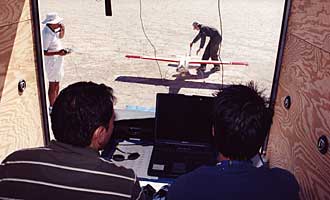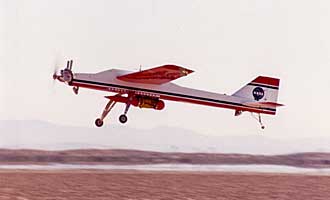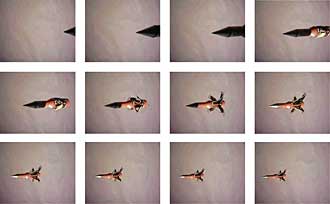- NASA Home
- | Centers
- | Dryden Home
- | News
- | X-Press
- | Stories
- | 2006
Search Dryden
Feature
DART:
Flight Research Hits the Mark
Flight Research Hits the Mark
July 31, 2006
 Image above: Tony Frackowiak, standing, left, and Tyler Beiter set up the
mothership and its underbelly passenger, the Sandia Dart research
vehicle while Jose Ruiz, left, and Victor Linn make final
preparations in the ground cockpit, to which control of the aircraft
will shift during its climb to mission altitude.
Image above: Tony Frackowiak, standing, left, and Tyler Beiter set up the
mothership and its underbelly passenger, the Sandia Dart research
vehicle while Jose Ruiz, left, and Victor Linn make final
preparations in the ground cockpit, to which control of the aircraft
will shift during its climb to mission altitude.NASA Photo by Tom Tschida
Dryden technicians integrated the Sandia Darts onto the center's utility vehicle aircraft and after several modifications, air launched the Darts from about 3,000 feet in an attempt to characterize the Darts' aerodynamics. The goal of the Sandia research project was to demonstrate the aerodynamic stability and flight performance of the Dart vehicle and embed it in the ground.
Dryden researchers integrated the Sandia-designed drop mechanism on the utility aircraft's underside and were tasked with devising a method of air launching the Darts accurately from a specified position as well as ensuring that they fell to the ground in a place from which they could then be retrieved. Among the challenges was getting the vehicle to embed at or near the ground surface in a variety of soils, said Steve Jacobson, Dryden's chief engineer for the Dart project.
The drop from 3,000 feet required the resolution of another challenge - a projectile as small as the Dart is difficult to see at 3,000 feet above ground level, or about 5,270 feet above sea level. In the past, aircraft released from the center's utility vehicle were launched at lower altitudes.
 Image above: Mark Howard takes a measurement of how deeply the Dart research
vehicle planted itself following an air launch from the mothership.
Image above: Mark Howard takes a measurement of how deeply the Dart research
vehicle planted itself following an air launch from the mothership.NASA Photo by Tom Tschida
"We had to put an autopilot on board to control our utility airplane because it flies so high that the pilot would have a difficult time controlling it," Jacobson explained.
Dryden Model Shop designer Tony Frackowiak said the integration of the equipment wasn't the difficult part. The utility model was designed for missions like air launching the 28-pound, 30-inch-long Dart, and integrating the autopilot was not hard. Mounting the four cameras on the aircraft, however, was a different story.
One video camera was added to each wingtip, one "chin" camera near the front of the aircraft to capture video of the Dart falling away and one at the tail. The camera work was for Dryden's benefit and it added a new capability for future flight experiments.
Additionally, Frackowiak said, completing simulations of how the hardware would work in the integrated systems and deriving the mathematical parameters, or gains, for the autopilot were challenging. Once the aircraft was ready and the 14 Dryden and five Sandia Laboratories personnel had completed preparations, it was time to fly. As is often the case with flight research, not everything went as planned.
"We became involved because we know how to fly airplanes and we know how to drop things off of airplanes," Jacobson said. "Sandia needed our help with the drop operations, providing the UAV and the infrastructure to support its flight. A primary objective of the test was (that) they wanted to be able to find it (after it came to rest on the ground). The very top of the Dart is the only thing that is supposed to be visible. In fact, the very first time we dropped it, it wasn't easy to find."
But researchers had a good idea of where to look. "We knew where it was supposed to be but winds were pushing it to one side," Jacobson said. "We had people stationed at various points and they walked line-of-sight to where they thought it would be. We knew based on the wind that the drop article would be in an oval-shaped area. When (researchers) walked to the same area from their position, we were literally within five feet of it and didn't know. It wasn't obvious to us."
A feature of autopilot was auto drop, which enabled researchers to know the Dart's path and direction and the point at which air launch would occur. Knowing the point of origin made finding the Dart easier after the first time, Jacobson said.
The autopilot was an off-the-shelf product, Cloud Cap Piccolo Plus hardware and guidance software. The autopilot used in the Sandia Darts project also was used in another Dryden project, Michael Allen's autonomous soaringresearch. Allen customized the autopilot so his hand-launched, motorized, model sailplane would catch plumes of rising air called thermals in much the same way as birds do, validating a thermal model developed at Dryden.
Dryden's ability to operate in restricted airspace is another unique feature of testing at the center, he added.
"Sandia wanted to show their drop article to their customer," he said. "The day we showed it (to their customer representatives) we had two drops and the operation was flawless. Because we had invested so much time in understanding the systems and practiced with a 'dummy Dart,' we had plenty of operational experience before the customer showed up. The day the customer showed up, things went off without a hitch."
 Image above: The mothership takes to the sky with a Sandia Dart research vehicle
secured beneath its fuselage. Air launch of the small Darts was
successful.
Image above: The mothership takes to the sky with a Sandia Dart research vehicle
secured beneath its fuselage. Air launch of the small Darts was
successful.NASA Photo by Tom Tschida
Dryden's utility aircraft has a 10-foot wingspan, is nine and one-half feet in length and weighs about 30 pounds in standard configuration. Takeoff weight for the Dart project was 76 pounds, the most the aircraft has carried, but Frackowiak said the aircraft likely could carry even heavier payloads with the larger engine he installed for the Sandia mission.
The Sandia-designed release mechanism consisted of a mounted, four-jaw "clamshell" that opens to allow the object to air-launch on release. It was spring-loaded with a pyrotechnic cutter to ensure the mechanism worked as intended. The Darts also can be released manually. Jacobson described the Darts' release from the utility vehicle as "smooth as glass."
"We have added a unique capability to the utility vehicle that increases the air-launch altitude from 1,000 to 3,000 feet, and it could go higher with this autopilot. The utility vehicle worked great and the releases were very smooth," he said.
 Image above: Photo sequence assembled from mothership onboard camera footage by Tyler Beiter
Image above: Photo sequence assembled from mothership onboard camera footage by Tyler BeiterThe autopilot is a new capability for the utility vehicle that is expected to have applications for future research.
"It certainly can be used for a variety of research - projects similar to the Darts, or any test item that needs to be flown," Frackowiak said.
Dryden also is working to develop a UAV trainer or proficiency system, which was really (the late Dryden engineer) Dale Reed's vision for the utility project, he added.
Frackowiak said the Dart demonstration flight also illustrated Dryden's capability with small UAVs.
"Subscale or smaller UAVs can accomplish many research objectives at a much lower cost and a shorter time frame," he said.
X-Press Editor